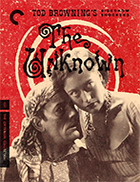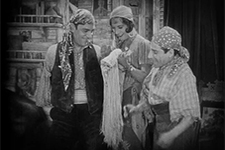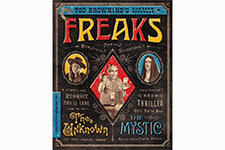| Director: Tod Browning | | Screenplay: Waldemar Young (story by Tod Browning; titles by Joseph Farnham) | | Stars: Lon Chaney (Alonzo), Norman Kerry (Malabar), Joan Crawford (Nanon), Nick De Ruiz (Zanzi), John George (Cojo), Frank Lanning (Costra) | | MPAA Rating: NR | | Year of Release: 1927 | | Country: U.S. |  |
|  Tod Browning’s The Unknown is his silent-era masterpiece and the greatest of his ten collaborations with star Lon Chaney. Although Browning directed films in a wide range of genres, in the 1920s he focused his talents on a series of criminal dramas that touched on elements that would come to define the horror genre, which he later had a hand in fully initiating with Dracula (1931) starring Bela Lugosi. And, while that Gothic adaptation of literature’s most famous vampire has its place in the history of horror, those who know and prize the genre’s darker, more twisted corners will find The Unknown, which features no supernatural monstrosities, but plenty of monstrous human behavior, much more galvanizing. At the time, Lon Chaney was one of the silent screen’s biggest stars—the self-described “Man of a Thousand Faces” who so memorably disappeared into macabre and unusual characters whose twisted physical forms were created with his own make-up design and application. Chaney’s characters were often mangled or deformed, which art historian Sidra Stich has argued was influenced by the influx of wounded veterans from World War I. Chaney played a legless factory tyrant in The Penalty (1920), a sympathetic hunchback assistant in A Blind Bargain (1922), and the titular protagonists of The Hunchback of Notre Dame (1923) and The Phantom of the Opera (1925). He often brought a tortured soulfulness to his characters, even those who, like The Phantom of the Opera’s Erik, would seem to be utterly monstrous. The irony of his character in The Unknown, a travelling circus performer named Alonzo, is that he seems, on the surface, to be quite normal, but inside is a monster whose desire for Nanon (Joan Crawford), a fellow circus performer, drives him to acts that are extraordinarily cruel. Alonzo is known in the circus as “Alonzo the Armless” because he has no arms and performs all kinds of amazing feats with his feet, which include shooting bullets and throwing knives at Nanon while she poses provocatively on a spinning platform (in a bit of pre-Code salaciousness, his first few gun shots are designed to shoot through the straps of her dress so it falls off, leaving her in decidedly more exposed). The film opens with a title card informing us that “This is a story they tell in old Madrid … it’s a story they say is true,” which adds an aura of old-world fatalism to the tale. Alonzo is obsessed with Nanon, who is drawn to him because he has no arms. For reasons that are never fully explained, Nanon is utterly repulsed by a man’s embrace, so Alonzo the Armless feels safe to her. She is also the object of desire for Malabar (Norman Kerry), the circus strongman who does not understand how she can resist his advances. Alonzo, however, has a secret: He actually has arms, which he keeps hidden under a constrictive leather corset into which is bound each day by his conspirator, a dwarf assistant named Cojo (John George). We learn that Alonzo is a wanted man for previous crimes, and his hiding in the circus and claiming to be armless keeps him from any suspicious (he has a double thumb on one hand, thus making him easily identifiable). However, his violent temper is still evident, as he murders Nanon’s father, the owner of the circus, one night, a violent event that Nanon briefly glimpses. Of course, she does not suspect Alozno because she sees her father’s murderer strangling him. To seal the deal and permanently transform himself, Alonzo blackmails a surgeon into amputating his arms for real, thus ensuring that Nanon will never discover that he murdered her father and that she will never fear his embrace. But then, in a particularly cruel (and yet deserved) irony, Nanon gets over her repulsion to a man’s embrace while Alonzo is secretly recovering from his surgery, and when he returns to the circus he finds her literally in Malabar’s embrace, which so enrages him that he attempts to sabotage his circus act and cause him to be ripped apart by horses. Chaney’s commitment to his performance is legendary, as he had his arms painfully bound to his body to make him appear convincingly armless (although he did have to resort to using a contortionist just out of the camera’s view to perform some of the complex footwork for which Alonzo is so famous). Chaney’s performance is not just physical, though, as the numerous close-ups that convey his anguish, conniving, and rage are all quite compelling and essential to the film’s emotional impact. Alonzo is a sick character, but one with whom we nevertheless identify, even as his romantic desires spill over into murderous obsession. Not surprisingly, the film was criticized in many quarters for its dark tone and sadomasochistic story, which probably could not have withstood the scrutiny of the Production Code a few years later. Thankfully, Browning and Chaney were allowed to pursue the dark corners of this twisted melodrama without restraint, resulting in one of the silent cinema’s great precursors to the horror genre. | Tod Browning’s Sideshow Shockers Criterion Collection 3-Disc Blu-ray Set |  This two-disc Blu-ray set contains three films: The Mystic (1925), The Unknown (1927), and Freaks (1932). This two-disc Blu-ray set contains three films: The Mystic (1925), The Unknown (1927), and Freaks (1932). | | Aspect Ratio | 1.33:1 (all films) | | Audio | English Linear PCM 1.0 monaural (The Unknown and Freaks)Linear PCM 2.0 stereo (The Mystic) | | Subtitles | English | | Supplements | Audio commentaries on Freaks and The Unknown by film scholar David J. SkalVideo introduction by Skal to The MysticTod Browning’s Freaks: The Sideshow Cinema documentaryVideo interview with author Megan Abbott about director Tod Browning and pre-Code horrorEpisode from 2019 of critic Kristen Lopez’s podcast Ticklish Business about disability representation in FreaksReading by Skal of “Spurs,” the short story by Tod Robbins on which Freaks is based Prologue to Freaks, which was added to the film in 1947Program on the alternate endings to FreaksVideo gallery of portraits from FreaksEssay by film critic Farran Smith Nehme | | Distributor | The Criterion Collection | | Release Date | October 17, 2023 | | | COMMENTS | | Criterion’s two-disc set “Tod Browning’s Sideshow Shockers” is a major release that reveals three of the director’s most significant later films in an all-new light. Freaks has been given its first high-definition transfer, which has it looking better than it ever has on home video (the last official release was back in 2005 on DVD); The Unknown has been restored and reconstructed for an all-new transfer; and The Mystic is being released on video for the first time in Region 1. Freaks certainly looks the best of the three films, as it was scanned in 5K from a 35mm nitrate duplicate negative and a 35mm safety print. The 1.37:1 image looks excellent, with solid detail, contrast, and black levels, which are particularly important in the dark, rainy climax. There are few if any signs of age and wear, and any digital restoration that was done has left intact the film’s fine grain structure. The Unknown was the hardest of the three films to restore, as an opening title card explains that it “was reconstructed from the only two surviving nitrate prints, a French-language version in the George Eastman Museum collection and a Czech-language version in the Národní filmový archiv, Prague.” The intertitles were “recreated based on the original cutting continuity provided by Jon Mirsalis.” The reconstruction, alas, was not perfect, as some material remains missing: “Based on the music cue sheet, the original release length of the film was 5,470 ft. The length of this reconstruction is 5,326 ft.” Nevertheless, this is a major improvement over previous DVD releases, even though the results are rough at times, with instances of irreparable damage and missing frames. The Mystic looks quite a bit better, even though it is two years older. That film was scanned in 2K from a 35mm safety fine grain print, which looks surprisingly clean for its age. As far as sound goes, Freaks’ original monaural soundtrack was restored by Criterion from an archival two-inch magnetic track. As an early synchronized sound film, its soundtrack is a bit thin and flat, but it works perfectly well. Both The Mystic and The Unknown have been given new musical scores. The Mystic features the better of the two, as sound designer and composer Dean Hurley has put together an engrossing, hallucinatory score that makes use of all manner of instruments including classical guitar, accordion, pump organ, and bells (not surprisingly, he has collaborated with David Lynch on a number of films). The soundtrack also features quite a few sound effects, such as footsteps, doors closing, papers rustling, and so on. The score for The Unknown by prolific silent film composer Philip Carli is quite good, as well, although it is a more conventional piano-only score. Not surprisingly, film historian and horror film expert David J. Skal, co-author of Dark Carnival: The Secret World of Tod Browning, Hollywood’s Master of the Macabre, had a major hand in many of the supplements. Skal provides informative new audio commentaries for both The Unknown and Freaks, as well as a 10-minute audio introduction to The Mystic. He is also recorded reading the entirety of “Spurs,” the Tod Robbins short story on which Freaks is based. The two-disc set also includes the 2004 documentary Tod Browning’s Freaks: The Sideshow Cinema, which runs an hour in length and previously appeared on the Warner Bros.’ Freaks DVD. We also get a new 30-minute interview with crime novelist Megan Abbott about Browning’s pre-Code film career. To give some further context for the controversies around Freaks, the disc includes a 2019 episode of critic Kristen Lopez’s podcast Ticklish Business, which focuses on the representation of disability in the film. From the archives we have the Dwain Esper-added prologue to Freaks, which was tacked on starting in 1947 and was misunderstood for years as being part of the original film; a 6-minute featurette about the film’s alternate endings; and a video gallery of portraits from Freaks. |
Copyright © 2023 James Kendrick Thoughts? E-mail James Kendrick All images copyright © The Criterion Collection |




 (4)
(4)

 This two-disc Blu-ray set contains three films: The Mystic (1925), The Unknown (1927), and Freaks (1932).
This two-disc Blu-ray set contains three films: The Mystic (1925), The Unknown (1927), and Freaks (1932).